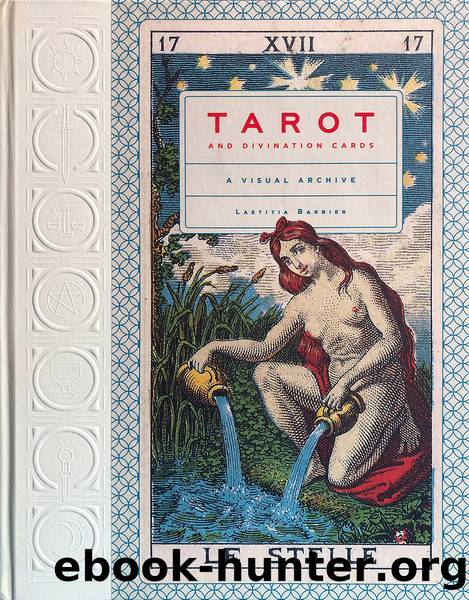Tarot and Divination Cards: A Visual Archive by Laetitia Barbier

Author:Laetitia Barbier
Language: eng
Format: epub
Publisher: Cernunnos
Published: 2021-11-25T00:00:00+00:00
Sun card from Oswald Wirth Tarot des Imagiers du Moyen Age, 1899.
The Last Judgement, published in Ãpinal, France, by Pellerin, 1876. From the Bibliothèque nationale de France.
JUDGEMENT
Rise up, Dead and come to your Judgement!â says the small printed text, the menacing words wrapped around the skull and crossbones at the bottom of this image dâEpinal. Above, a disquieting scene presents itself to us. We see God, materialized in our own sky, holding the Divine Law in his hand, symbol of his omnipotent authority. The bearded Lord is flanked by Jesus Christ his son, the Virgin Mary, John the Baptist, a profusion of biblical patriarchs and other cast members, including the apostles, serving as Grand Jury in this heavenly court. A flamboyant tribunal resting on puffy clouds, looking down at us. This trial is indeed a very public affair. On land, Chaos reigns. The dead are back to life, awakened by the clamor of angelic trumpets. Confused, these naked souls run amok, jetting out of their grave, galloping in the fields before being caught by angels or demons. Like shepherds gathering packs of senseless sheeps, these strange emissaries divided the crowd in two groups, sometimes against their will, according to their ultimate destination. Heaven or Hell.
In the center of this depiction, Saint Michael is simultaneously subduing the forces of Evil and serving as a protector for the vulnerable ones being judged. The archangel is equipped with a sword and a scale, two attributes reminiscent of the one of Justice, symbolizing equity and impartiality. His role, in this intense spectacle, is to weigh souls, count good deeds against bad ones and secure a safe passage to the candidates granted access to the Kingdom of Heaven.
In the tarot, the Judgement card is clearly inspired by the iconography of the Last Judgement, a motif directly borrowed from Christian eschatology and the sinister visions of what is supposed to happen to us at the end of time. Amply represented during the medieval era and the Renaissance, the Last Judgement depictions are visible in a plethora of churches and altar pieces, their great number and somber quality granting them the ominous title of âDoom paintings.â Like any artistic trope, they follow a set of visual rules, and the most transparent one is that we are not witnessing a happy ending. Terror is palpable, translated in the supplicative gesticulations of the herd of souls as they are to be either damned or saved. In the Stephan Lochner exemple, we see allegories of heaven and hell, shown respectively as an immaculate cathedral and a fortress in flames. As we look at these terrifying depictions, we are meant to internalize the moral perils of disobeying the divine laws.
Nevertheless, the images we encounter in the tarot are suddenly different, the visual convention of Doom paintings have been somehow evacuated. Reframed to one specific narrative line, the Judgement cards do not share their frantic heaviness, nor many of their disturbing tropes. Visions of God as a wrathful authority are absent and the focus is mostly on the Angels trumpeting, the wake-up call.
Download
This site does not store any files on its server. We only index and link to content provided by other sites. Please contact the content providers to delete copyright contents if any and email us, we'll remove relevant links or contents immediately.
Kathy Andrews Collection by Kathy Andrews(11708)
The remains of the day by Kazuo Ishiguro(8788)
Paper Towns by Green John(5065)
Spare by Prince Harry The Duke of Sussex(5054)
The Body: A Guide for Occupants by Bill Bryson(4953)
Industrial Automation from Scratch: A hands-on guide to using sensors, actuators, PLCs, HMIs, and SCADA to automate industrial processes by Olushola Akande(4916)
Machine Learning at Scale with H2O by Gregory Keys | David Whiting(4106)
Be in a Treehouse by Pete Nelson(3924)
Never by Ken Follett(3762)
Harry Potter and the Goblet Of Fire by J.K. Rowling(3759)
Goodbye Paradise(3710)
Into Thin Air by Jon Krakauer(3289)
The Remains of the Day by Kazuo Ishiguro(3280)
The Cellar by Natasha Preston(3242)
The Genius of Japanese Carpentry by Azby Brown(3209)
Fairy Tale by Stephen King(3193)
120 Days of Sodom by Marquis de Sade(3161)
The Man Who Died Twice by Richard Osman(2979)
Drawing Shortcuts: Developing Quick Drawing Skills Using Today's Technology by Leggitt Jim(2975)
